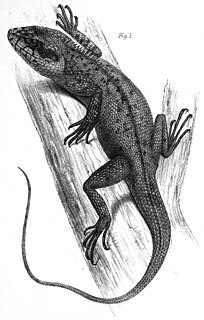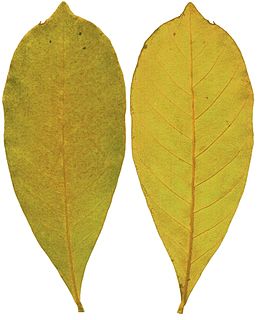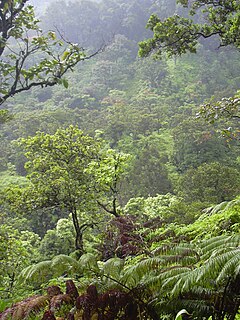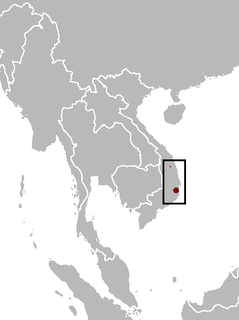
Pseudocalotes is a genus of agamid lizards endemic to Southeast Asia.

Mallotus is a genus of the spurge family Euphorbiaceae first described as a genus in 1790. Two species are found in tropical Africa and Madagascar. All the other species are found in East Asia, the Indian Subcontinent, Southeast Asia, eastern Australia, and certain islands of the western Pacific. The genus has about 150 species of dioecious trees or shrubs.
Lasiococca is a plant genus of the family Euphorbiaceae first described in 1887. These are small to relatively large trees found in scrubs or semi-evergreen forests. They grow in India, Indochina, Southeast Asia, and southern China.
- Lasiococca brevipes(Merr.) Welzen & S.E.C.Sierra - Peninsular Malaysia, Philippines, Lesser Sunda Islands, Sulawesi
- Lasiococca chaniiThin - Vietnam
- Lasiococca comberiHaines - Hainan, Yunnan, Vietnam, Thailand, E India
- Lasiococca lociiThin - Vietnam
- Lasiococca symphylliifolia(Kurz) Hook.f. - Sikkim

Pseudocalotes austeniana, also known commonly as the Abor Hills agama or Annandale's dragon, is a rare species of lizard in the family Agamidae. The species is endemic to Asia.

Pseudocalotes kakhienensis, the Kakhyen Hills spiny lizard, is a species of agamid lizard found in southern China, Myanmar, India, and northern Thailand. Type locality: Ponsee, Western Yunnan.

Synsepalum brevipes is a shrub or medium-sized to large tree in the family Sapotaceae, that is native to the African tropics and subtropics.

Pelophryne brevipes is a species of toad in the family Bufonidae. It is endemic to the Philippines and found on the islands of Mindanao and Basilan. Records from elsewhere in Southeast Asia refer to Pelophryne signata or possibly other species. Common names Southeast Asian toadlet and Zamboanga flathead toad have been coined for it.

Bobea is a genus of flowering plants in the family Rubiaceae. All species in this genus are endemic to Hawaii. Bobea was named for Jean-Baptiste Bobe-Moreau by Charles Gaudichaud-Beaupré in 1830 in his book Voyage de l'Uranie.
Oxanthera is a genus of flowering plants in the citrus family, Rutaceae. They are endemic to New Caledonia. They are known commonly as false oranges.

The Vietnam mouse-deer, also known as the silver-backed chevrotain, is an even-toed ungulate in the family Tragulidae known only from Vietnam. It was first described in 1910 by British zoologist Oldfield Thomas, who procured four specimens from Nha Trang in Annam. Little is known about its distribution and ecology. After 1910, the Vietnam mouse-deer was reported next in 1990 near Dak Rong and Buon Luoi in the Gia Lai Province. With increasing hunting pressure, habitat loss due to deforestation and no more reports of the species in the wild, the mouse-deer was feared to have gone extinct. The IUCN listed the species as Data Deficient in 2008. In 2019, a study confirmed the presence of the Vietnam mouse-deer in dry low-lying forests of southern Vietnam with camera trap evidence. The mouse-deer is characterised by a rough coat with a strange double-tone coloration unseen in other chevrotains; the front part of the body is reddish brown and contrasts strongly with the greyish posterior. It has big reddish brown ears, white and dark reddish brown marks on the throat.
Pseudocalotes khaonanensis is the largest agamid lizard in the genus Pseudocalotes. Endemic to Thailand, it is found only in the Khao Nan mountain range in, located in the Nakhon Si Thammarat Province of Southern Thailand. Found at high elevation in Cloud/Montane Forests in the stunted tree growth associated with this habitat, in trees rich with epiphyte growth.

Flemingia is a genus of flowering plants in the legume family Fabaceae. It is native to Asia and the species are distributed in Bhutan, Burma, China, India; Indonesia, Laos, Malaysia, Nepal, Pakistan, Papua New Guinea, Philippines, Sri Lanka, Taiwan, Thailand and Vietnam. The genus was erected in 1812.

Pseudocalotes andamanensis is an agamid lizard found on the Nicobar Islands and the Andaman Islands in India. It is also known as the green crestless forest lizard, Andaman and Nicobar forest lizard, Andaman lizard, or Andaman green calotes. This species is an almost exclusive canopy dweller, and is rarely seen.

Pseudocalotes microlepis, also known as Burmese false bloodsucker or small-scaled forest agamid, is a species of agamid lizard in the genus Pseudocalotes found in southern China, Thailand, Laos, Myanmar and Vietnam.

Pseudocalotes floweri, the Thai false bloodsucker or Flower’s forest agamid, is a species of agamid lizard. It is found in Thailand, Cambodia, and Vietnam.
Elaeocarpus stipularis is a tree in the Elaeocarpaceae family. It is found from the Aru Islands, eastern Indonesia, to Philippines, and through Mainland Southeast Asia to Odisha, India. It has edible fruit, its wood is used and some medical uses are ascribed to it.
Pseudocalotes bapoensis is a species of agamid lizard. It is endemic to China.
Pseudocalotes kingdonwardi, Kingdonward's bloodsucker, is a species of agamid lizard. It is found in China and Myanmar.
Pseudocalotes poilani, the Laotian false bloodsucker, is a species of agamid lizard. It is found in Laos












